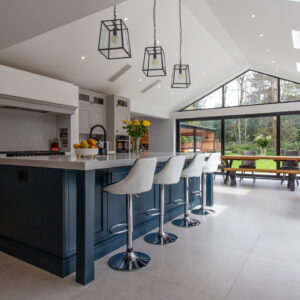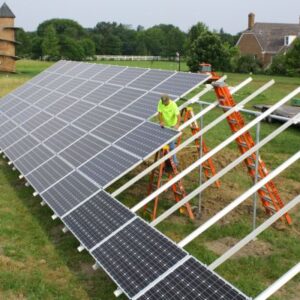
We have engineered our lives for speed. We exist in a culture of “instant-on,” an ecosystem of on-demand services, immediate communication, and smart devices that promise to eliminate friction from our daily existence. We have optimized our homes for efficiency, turning them into responsive machines that obey our voices and anticipate our needs. But in this relentless pursuit of “fast” convenience, we have begun to confuse it with “comfort.” We have built ourselves a world that is incredibly convenient, yet oddly dissatisfying. This digital, “fast-tech” environment has a sensory “jitter”; it is a world of blue light, incessant pings, and superficial interactions.
This same philosophy has quietly poisoned our most fundamental domestic comfort: our warmth. We have embraced “fast heat.” This is the heat of the forced-air furnace, the lightweight convector, or the digital space heater. It is a heat that is “on” or “off,” a binary, all-or-nothing proposition. It blasts a room with hot, dry air to satisfy a digital thermostat, and then just as quickly, it shuts off, leaving a residual chill. This “fast” warmth is effective, but it is also aggressive, shallow, and acoustically intrusive. It is the “fast food” of thermal comfort.
Now, a quiet but profound counter-movement is taking hold. It is a movement that rejects the “fast” in favor of the “deep.” It is a philosophy that prioritizes the quality of an experience over its speed. We have seen this in “slow food” and “slow fashion,” and now it has come for our homes in the form of “slow heat.” This is a return to a more profound, elemental, and haptic form of comfort. It is a warmth that is felt, not just measured; a warmth that is stable, silent, and enveloping. And the unassuming icon of this entire revolution is one of the oldest and most substantial heating technologies ever created: the cast iron radiator.
The Sensory Friction of “Fast Heat”
To understand the “slow heat” revolution, one must first dissect the deep sensory flaws of our modern “fast heat” systems. The primary method of heating in most modern homes is convection using a heating element to warm air, which then circulates. This is most commonly experienced as a forced-air system, which uses a powerful fan to blow hot air through ducts, or a lightweight steel panel radiator, which is designed to heat the air directly around it as quickly as possible. This approach, while “responsive,” creates an environment of significant sensory friction.
First, there is the acoustic friction. “Fast heat” is loud. It is the sudden, intrusive whoosh of a furnace igniting in the basement, a sound that rips through the quiet of a home. It is the whir of fans, the metallic pinging and clanking of expanding ductwork, or the ticking of a thin panel radiator as its metal rapidly heats and cools. These sounds, while often relegated to “background noise,” are a persistent, low-level stressor, preventing our homes from ever achieving a state of true, deep quiet.
Second, there is the haptic (touch) and atmospheric friction. This method of heating is fundamentally aggressive. It creates a “thermal blast”—a directional gust of hot, bone-dry air. This process is incredibly drying, pulling humidity from the atmosphere, from our skin, and from our respiratory tracts, leading to the familiar “winter” afflictions of static, itchy skin, and irritated sinuses. This hot air is also a perfect vehicle for circulating pollutants. It actively churns the air in the room, picking up dust, pollen, pet dander, and mold spores, keeping them in constant airborne circulation for us to inhale. This entire sensory experience the noise, the dryness, the airborne dust—is a poor substitute for the deep, stable, radiant comfort provided by a traditional cast iron radiator, which operates on an entirely different and superior physical principle.
Finally, “fast heat” creates a “false” warmth. Because hot air rises, these systems create a state of “thermal stratification.” The hottest air in the room pools uselessly at the ceiling, while the coldest air settles on the floor. This is why you can feel “warm” from the neck up while your feet remain cold, a classic state of discomfort. The system is constantly fighting physics, blasting on and off to maintain a single set point on a thermostat, creating a jarring, unstable environment of hot spikes and chilly valleys.
The Radiance Principle: Heating People, Not Just Air
The “slow heat” provided by a cast iron unit is not just an incremental improvement; it is a different physical phenomenon. It operates primarily on the principle of radiant heat, not convection. This is the same kind of heat you feel from the sun on a cool day, or the deep warmth that emanates from a large stone fireplace long after the fire is out. It is a fundamental shift in philosophy: the goal is not to heat the air in the room, but to heat the objects in it.
A cast iron radiator emits long-wave infrared radiation. These waves travel in straight lines, pass through the air with minimal loss, and are absorbed by any solid mass they encounter. This includes the walls, the furniture, the floor, and, most importantly, the people in the room. These objects, now “charged” with thermal energy, then gently radiate that heat back into the space. The entire room—its very structure—becomes the heater.
The haptic experience of this is profound. Instead of being “hit” by a directional blast of hot air, you are “enveloped” by a 360-degree field of uniform warmth. The “cold spot” by the window vanishes. The floor becomes as warm as the air at eye level. The temperature from floor to ceiling remains remarkably stable. This “thermal embrace” is a deep, penetrating warmth that our bodies register as far more comforting and natural. Because it does not heat the air directly, it also does not “burn” the humidity out of it. The air remains clean, still, and naturally humid, eliminating the dryness, static, and respiratory irritation of “fast heat” systems.
The Virtue of Inertia: Why “Slow” is the New “Smart”
In our modern vernacular, “slow” is a pejorative. We want instant results. The cast iron radiator is, by its very nature, slow. Its incredible density and mass—its “thermal inertia”—mean it takes a significant amount of time to heat up. This, in the “fast heat” paradigm, is seen as a fatal flaw. But in the “slow heat” philosophy, this is its single greatest virtue. That slowness is intrinsically linked to its greatest strength: it is also incredibly slow to cool down.
This is the “thermal battery” effect. The radiator is not just a heat exchanger; it is a heat repository. It absorbs and holds a tremendous amount of energy within its dense iron core. This completely decouples the room’s comfort from the boiler’s firing cycle. In a “fast heat” system, the moment the boiler shuts off, the room begins to cool. In a “slow heat” system, the boiler shuts off, and the radiator’s massive iron core continues to silently pulse a steady, consistent, and gentle stream of radiant heat into the room for hours.
This “thermal coasting” is the very definition of luxury. It erases the on-off, hot-cold jolts of a conventional system. The temperature of the room doesn’t spike and crash; it floats, remaining remarkably stable and unwavering. This stability is not just more comfortable; it is often more efficient. By providing a consistent thermal baseline, the radiator allows the boiler to run in longer, more efficient cycles rather than the short, wasteful “bursts” required to constantly reheat a “fast” system that has lost all its warmth. This “slowness” is, in fact, the smarter, more sophisticated approach to thermal management.
The Atmospheric Dividend: A Return to Stillness
Beyond the haptics, the “slow heat” movement is a reclamation of our other senses. A cast iron radiator is a silent partner. It has no moving parts. No fans, no blowers. A properly balanced hydronic system is virtually inaudible. The only sound is the almost imperceptible whisper of water. This profound silence is a stark contrast to the acoustic pollution of forced-air systems. The luxury of “no sound” is a calming, restorative force, allowing a home to finally feel like a true sanctuary.
This stillness has a direct impact on atmospheric health. The “still” radiant heat does not create the powerful, room-churning convection currents that “fast heat” relies upon. This is a critical benefit. Dust, pollen, and pet dander are no longer being perpetually kicked up and circulated into the air we breathe. They are allowed to settle, where they can be removed by normal cleaning. The air is not just warmer; it is quantifiably cleaner. This makes a radiant system the unequivocally superior choice for anyone with allergies, asthma, or respiratory sensitivities. It is a system that provides warmth without poisoning the atmosphere, a system that works with our well-being, not against it.
Conclusion: The Return to the Real
We are beginning to emerge from our “fast-tech” fever dream. We are re-learning that “faster” does not always mean “better,” and that “convenient” is not a synonym for “comfortable.” The cultural shift toward slow heat is a symptom of a larger desire for things that are real, substantial, and permanent. It is a rejection of the superficial, disposable, and “jittery” environment we have accidentally built for ourselves.
To choose a cast iron radiator is to make a philosophical statement. It is a choice to prioritize the quality of our comfort over the speed of its arrival. It is an investment in a haptic, sensory experience—an enveloping, silent, and stable warmth that “fast heat” can never replicate. It is an investment in an object of substance, a “thermal battery” that will perform its function with quiet, analog grace for a hundred years, long after our smart thermostats and digital controls have become obsolete. In our quest for the perfect modern home, we are discovering that the most futuristic and luxurious comfort is not found in a new line of code, but in the elemental, honest, and profound “slow warmth” of a solid iron heart.





